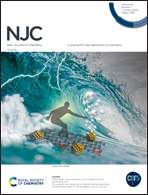UV-absorbing benzamide-based dendrimer precursors: synthesis, theoretical calculation, and spectroscopic characterization†
Abstract
The ability to tune the structural properties with respect to size, polarity, and terminal functionalities makes dendrimers a highly attractive class of compounds with potential biological and catalytic applications. In the present study, Janus (J) and Twin (T) benzamide-based branched structures were synthesized from a primary precursor of methyl gallate and then further characterized using spectroscopic and theoretical techniques. The optimized structures of these dendrimer precursors at the B3LYP/6-311G(d) level revealed that the aliphatic chains in the most stable forms are oriented in the least strained arrangement with the (–benzene–O–CH2−) linkage adopting the phenol-like configuration. UV–Vis spectra showed a consistent absorption at nearly 290 nm, suggesting that both molecules absorb within the ultraviolet region and are colorless. Prominent bands, which include the –OH vibrational stretch, the –C![[double bond, length as m-dash]](https://www.rsc.org/images/entities/char_e001.gif) C– stretch, the –C
C– stretch, the –C![[double bond, length as m-dash]](https://www.rsc.org/images/entities/char_e001.gif) O stretch, the –C–O in-plane stretch, and the –NH in-plane bending, were assigned and correlated with the structural and electronic aspects of the molecules.
O stretch, the –C–O in-plane stretch, and the –NH in-plane bending, were assigned and correlated with the structural and electronic aspects of the molecules.



 Please wait while we load your content...
Please wait while we load your content...